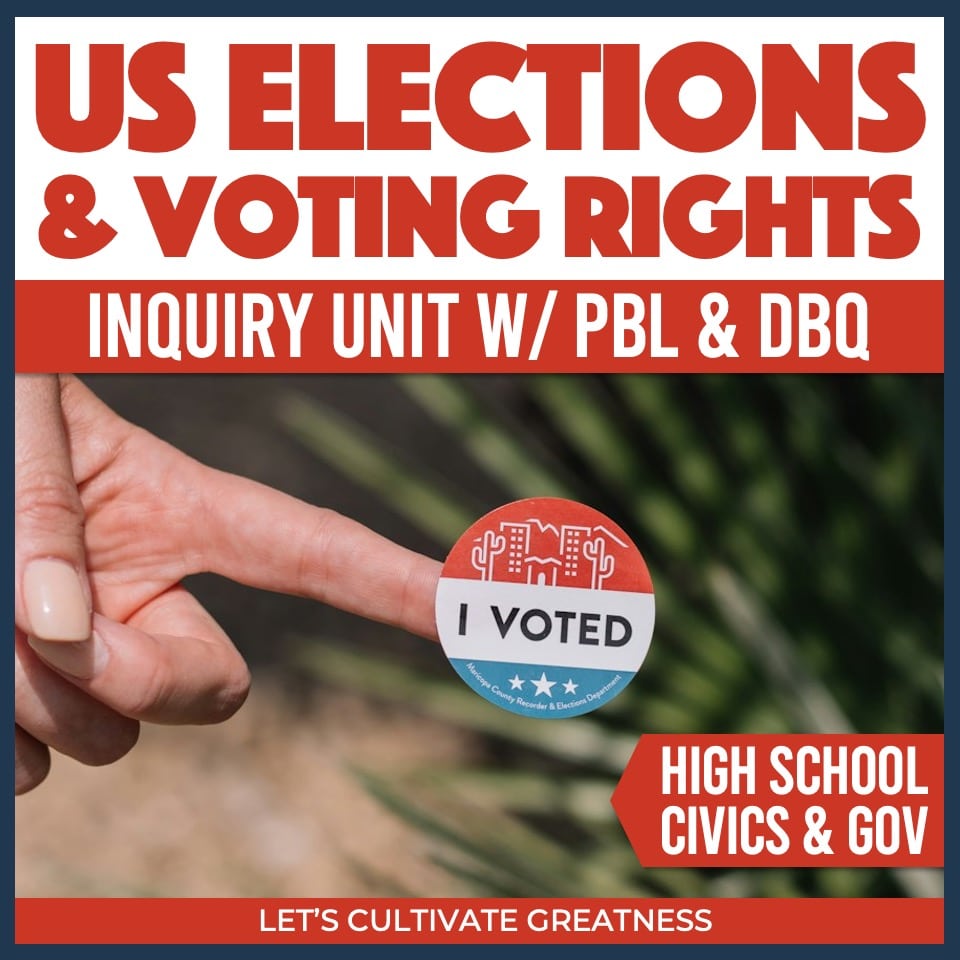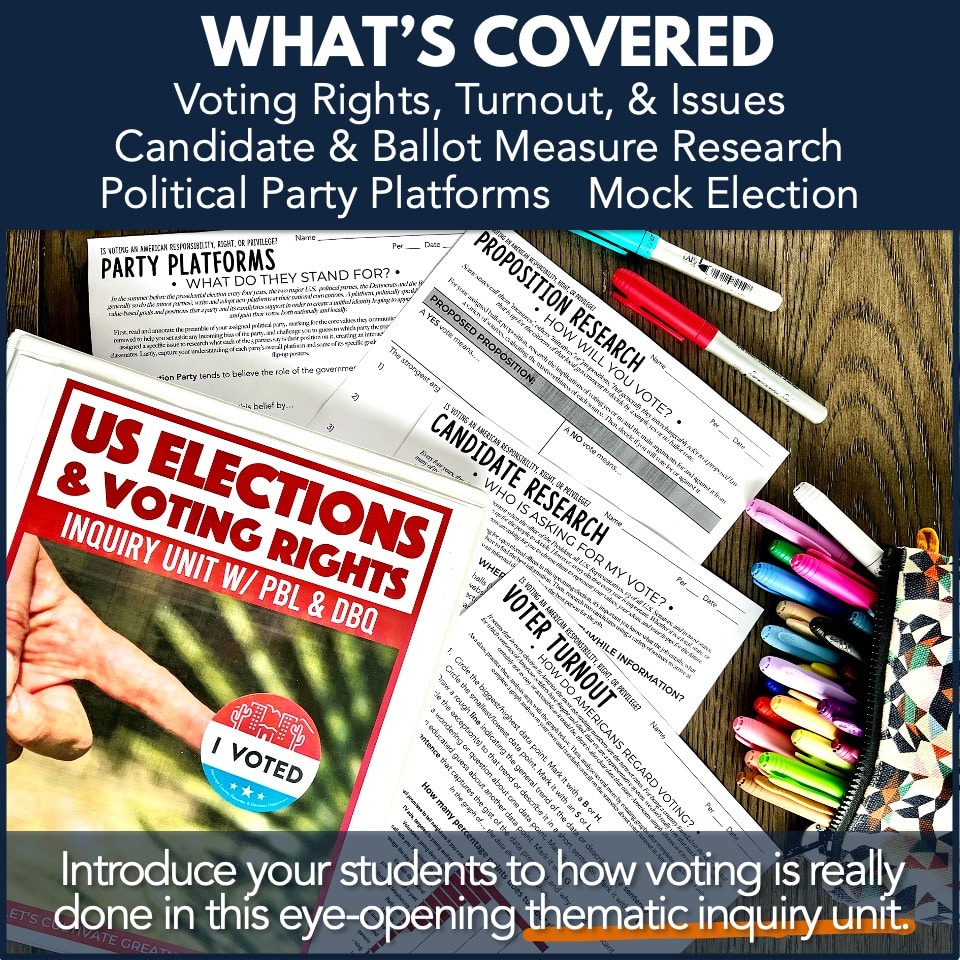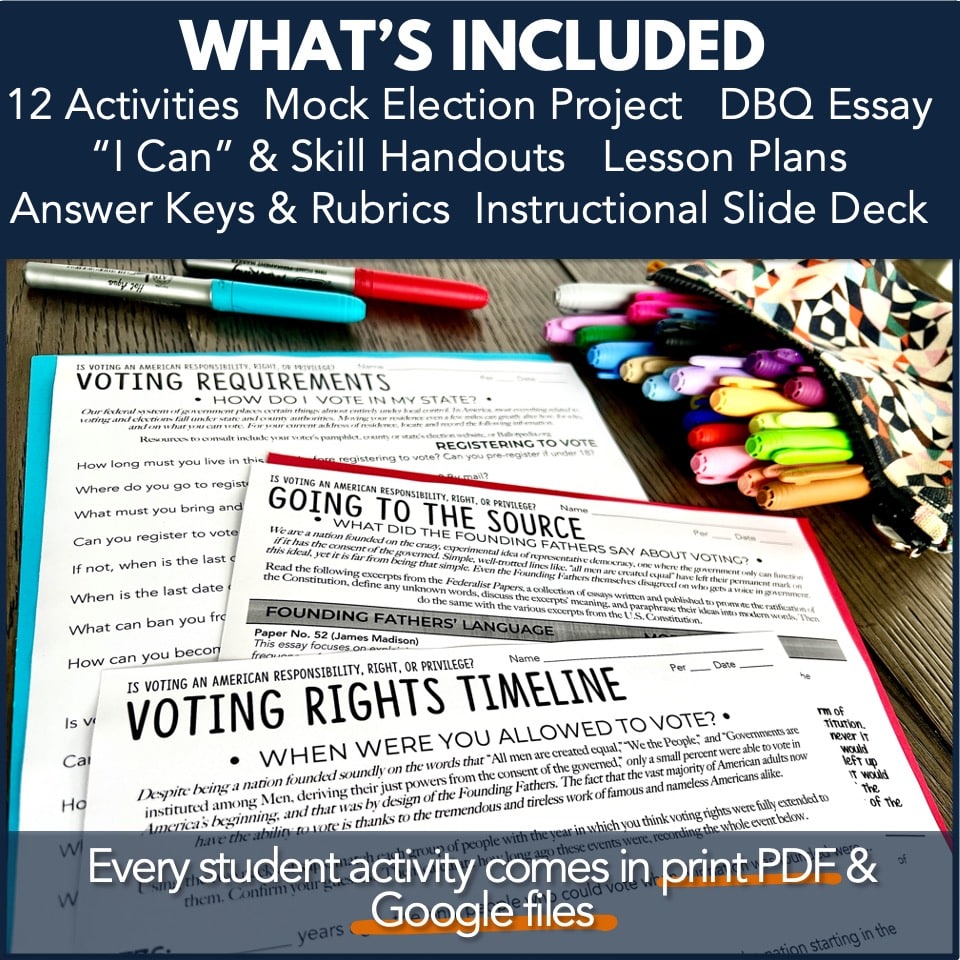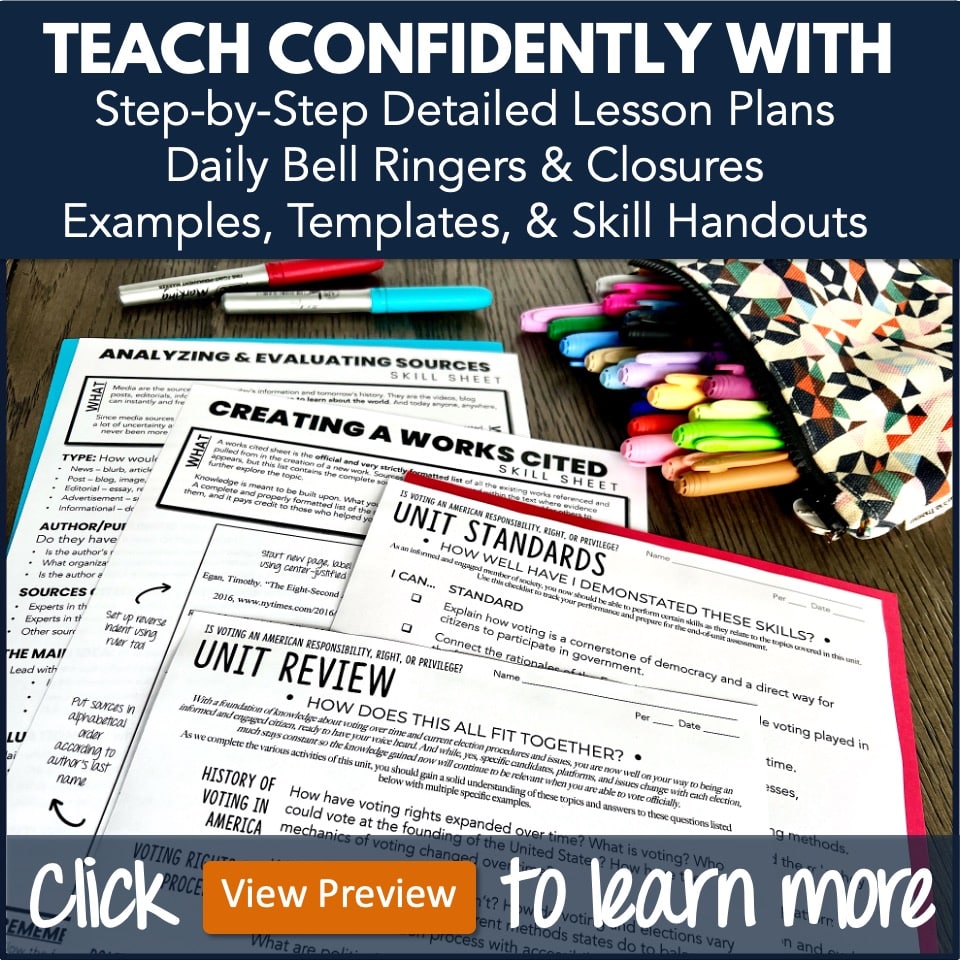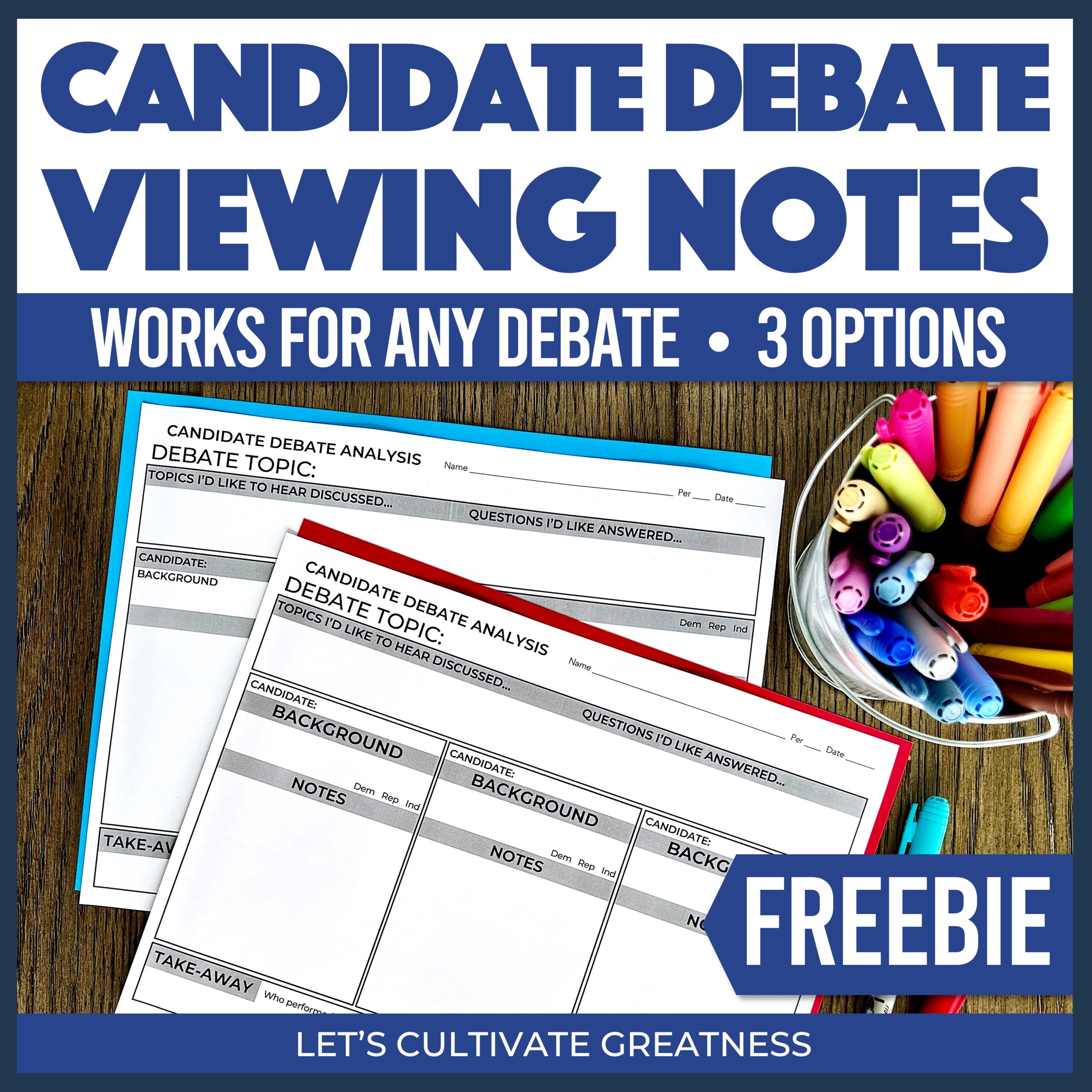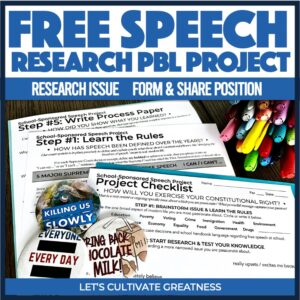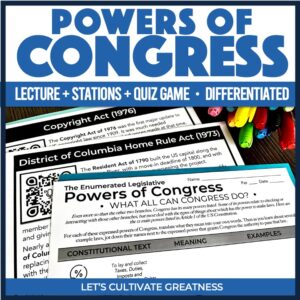Voting & Elections Inquiry PBL & DBQ Unit
$29.95
Explore voting rights, voting behavior, and turnout, this election’s candidates, and political party platforms, culminating in a mock election.
This inquiry-driven, source-based PBL unit asks students to answer, “Is voting a responsibility, a right, or a privilege?”
Description
An inquiry unit immediately makes abstract concepts into intriguing and relevant lessons.
Each activity is driven by a guiding question that builds towards the unit question as well as has students exploring current issues and relevant examples.
The unit culminates with students answering the question in a DBQ-style essay and an optional authentic PBL project.
This unit can be done well in between 3-5 weeks, especially leading up to Election Day, and has been crafted to support the standards of various states.
Included in this complete Voting and Election unit:
Overview
- Teacher Unit Overview with general notes, links, standards, and a pacing guide
- Daily Lesson Plans with step-by-step details, planning, and lesson takeaway notes
- Detailed Answer Keys for each activity
- Instructional Slide Deck slides to support activities and essay writing
- Student Unit Review and Skills handouts with self-checking questions and “I Can…” statements
- Student Unit Notes sheet for building deep and nuanced mastery of concepts over the course of the unit using powerful graphic organizers
- Student Skill Handouts that include Analyzing News Media Sources, Analyzing Political Cartoons, Deciding a Precise Position, Creating a Thesis Statement, and Including Evidence
Student Activities
- Voting Rights Timeline Match-Up hook students in with this eye-opener collaborative activity to match the year Americans got their right to vote
- Responsibility, Right, and Privilege Brainstorm deeply consider the meaning of each of these concepts and their differences
- Voting Rights Podcast Notes provide an overview with an engaging Civics 101 episode on the history of voting rights in America
- Going to the Source analyze Federalist Papers’ excerpts and Constitutional amendments about voting
- Voting Requirements research the laws, methods, and deadlines to voting in your state and compare different methods used across the country like mail-in voting
- Party Lines map out the red and blueness of America, reflecting on how these labels are oversimplified
- Political Party Brainstorm assess incoming knowledge of five different parties and analyze each’s platform preamble to guess to which party it belongs
- Party Platforms Posters research and share how each party believes various issues should be addressed
- Campaign Ads analyze and evaluate various flyers and commercials for persuasive devices
- Candidate Research explore campaign websites, voter pamphlet guides, and newspapers endorsements to learn about each candidate
- How We Vote provide an overview with an engaging Civics 101 episode on the history of Election Day and the actual act of voting
- Voter Turnout analyze various data charts on why some vote and some don’t and who these people are
- Proposition Podcast Notes provide an overview with an engaging Civics 101 episode on the origins and role of ballot propositions
- Proposition Research & Discussion deep dive into one proposition on the upcoming ballot by examining and weighing supporting and opposing arguments
- Political Cartoon & News Media Analysis connect concepts to real-life current issues with these universal forms and analysis strategies, perfect for weaving in a few throughout the unit
- Print PDF & editable Google versions of all student sheets included!
2 Summative Assessments
- End-of-Unit Essay support your students with a collaborative brainstorm review activity, detailed instructions, outline template, sentence stems, and rubrics, that encapsulate their complete understanding by arguing their answer to the not-so-simple question, “Is voting an American a responsibility, right, or privilege?” (step-by-step slides included!)
- Mock Election Project after guiding students through careful, balanced research, preparing them to become real-life voters as adults (editable ballot file included!)
ELL & Neurodiversity Supports
- Manipulatives & graphic organizers in activities to assist in concept understanding
- Collaborative, small-group activities that utilize spatial and kinesthetic skills and promote low-stakes student talk
- How-to skill sheets for essay writing skills
- Clear fonts and visual organization best practices used assignment sheets
This resource is 113 PDF pages, plus Google files.
What grades is this intended for?
This was designed at a mixed-ability high school level. I cannot guarantee it for grades younger than that, though middle school teachers have reported success with the units in this course.
If you teach middle school, you may succeed best with the stand-alone activity kits available.
What supports are included? How can I modify this?
Activities are built with included supports to accommodate varying needs within a typical on-level course: sentence stems, graphic organizers, chunking, small-group and low-stakes student talk, manipulatives, how-two skill sheets, step-by-step essay and project forms, etc.
Student materials come in editable Google file versions to allow you to modify activities by shortening, re-leveling, translating, or using text-to-speech software to support student needs.
Can I use this in a homeschooling setting?
Sure! While this unit was designed with a traditional classroom setting in mind, it can be used in a solo or a small-group setting without too much tweaking.
Is this editable? What file types does this resource come in?
The main resource is a secured, non-editable PDF file intended to be printed. Included are links to editable Google files of all the student materials.
What standards does this address?
Several! Standards vary, but this resource supports these from various states:
- Describe the election process at the local, state, and national level
- Analyze the role as well as the similarities and differences among the major and minor political parties and their platforms
- Describe the voter registration and voting processes
- Analyze various ways in which US citizens can exercise political particpation
- Participate in simulations exercising the responsibilities of citizenship
- Analyze trends in voter turnout
- Explain how voting rights have expanding over time
- Analyze and evaluate political communication (like cartoons, campiagn advertisements, party platforms) for bias, emotional appeal, and factual accuracy
- Dicuss current public issues and solutions
- Analyze primary sources, determining central idea, citing textual evidence, and identifying author’s point of view and purpose
- Integrate multiple sources in diverse formats in order to form a coherent understanding and address a question
- Write argument focused on discipline-specific content, developing claim and counterclaim, selecting most signfignat pieces of evidence, using precise domain-specific language, and organizing ideas into a coherent arugment
- Make personal and real-world connections and refections to content
What are the terms of use for this resource?
This resource, including all ancillary files, may be used as needed for regular, non-commercial single-classroom use between a teacher and their students.
This includes printing copies and sharing digital files with students through a secure platform, like Google Classroom or Canvas, email, or a classroom-only shared drive.
The using and sharing of any part of this resource in any manner outside the above-mentioned capacity is strictly prohibited. Prohibited uses include, but are not limited to,
- posting files on the open internet or in a Facebook group
- emailing files to or sharing print copies with others (without purchasing additional licenses)
- uploading or storing files in a shared cloud drive accessible by anyone other than students
- including any part, or any derivative work, within any commercial endeavor like curriculum development, professional training, or for-profit teaching like Outschool, or selling this resource as your own in either print or digital formats
Doing so violates the Digital Millennium Copyright Act (DMCA), copyright law, and these terms.
By downloading this resource from Let’s Cultivate Greatness, the original user has been granted one license for a single teacher (or number of teachers matching the number of licenses purchased) and their students at any one time.
Let’s Cultivate Greatness retains the full copyright of this resource.
I loved how each lesson ties to the essential question, and how lessons can be tailored for specific students. When it came time for the end-of-unit essay, my students could simply look back at each of the prior lessons for their evidence! This resource is well-planned and rigorous. – Jonathan W.
I used this as a foundation for my Voting unit for my 7th graders. Although intended for high school students, the resources were very helpful for my middles! While some resources were a little too advanced for my students, the student notes/worksheets and teacher guides, were a saving grace. Thank you for helping out this first year teacher! – fellow TPT seller
This is a great resource--- it's hard to find higher level civics projects, and this allows students to discover on their own, while still including a teacher-centered grasp (seniors can sometimes get off task if you let it be too open-ended). FANTASTIC resource with everything I needed. – fellow TPT seller

